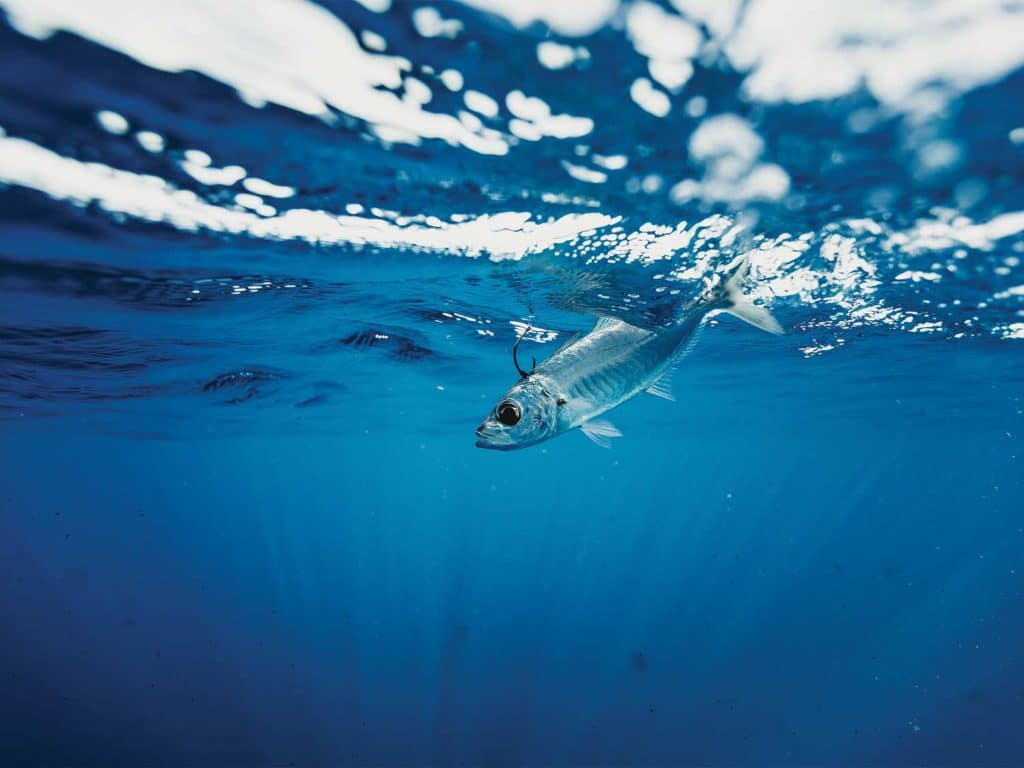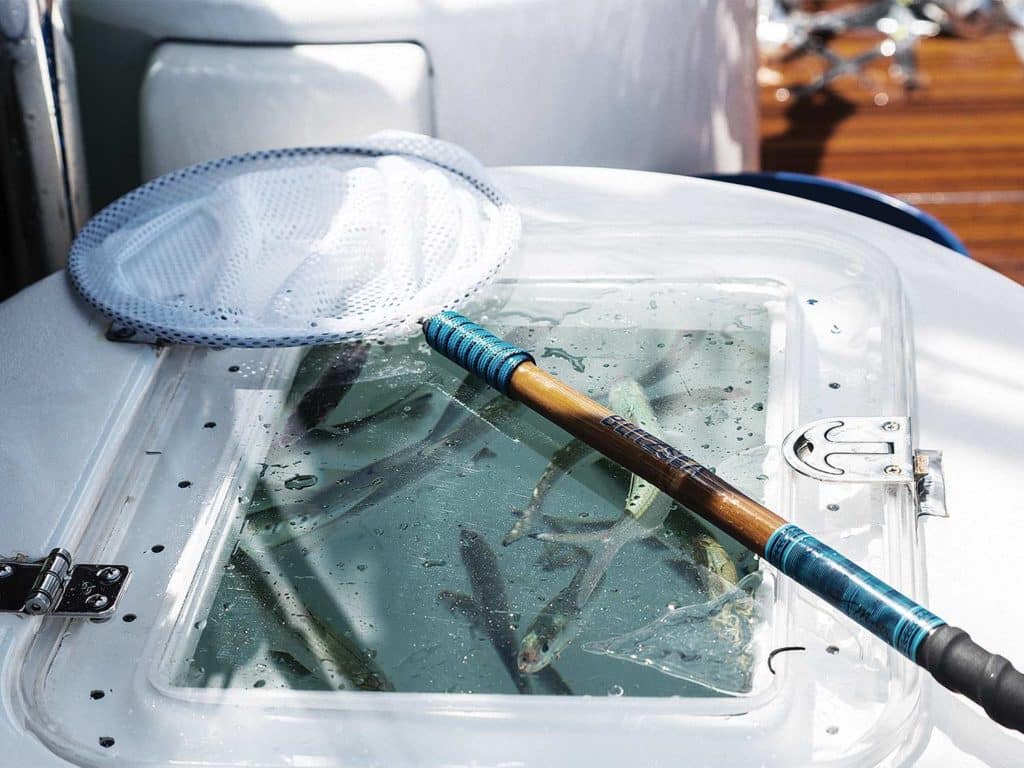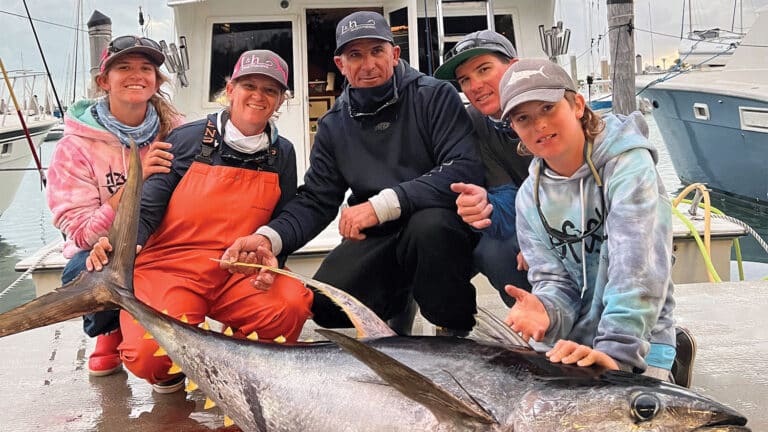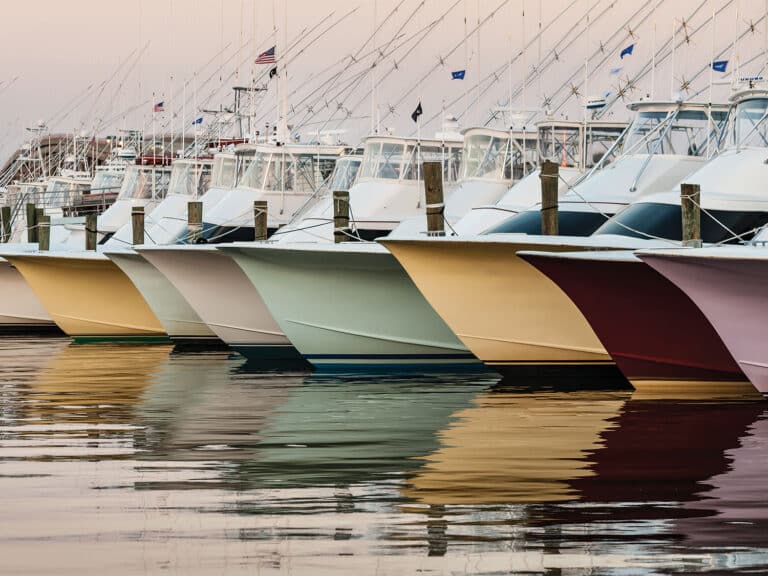
When you’re fishing for any pelagic species, it’s hard to beat healthy live bait, especially in South Florida where kite fishing is king. Merely catching enough bait for a single fishing trip can be tricky, and depending on weather, tides and moon phase, it’s sometimes necessary to catch your bait well ahead of time. Add tournament fishing to the mix and it becomes downright challenging. The best live-bait teams catch—and pen up—their own bait weeks, or sometimes even months, in advance.
Bait Wells and Pump Systems
The first step in keeping your live bait lively is having a good livewell and saltwater pump system. The shape and size of the livewell is vital, with the rule of thumb for keeping freshly caught bait at 1 gallon of seawater per baitfish. If you plan to pen up your bait for future use and you overcrowd the livewell, you could have a substantial die-off.
The shape of the livewell is almost equally important: almost all live bait needs to be swimming continuously to pass water over their gills. For this reason, a 100-gallon round livewell works the best. Not only does it have enough room to hold a minimum of 100 baits, because it’s round, there are no corners for the bait to get trapped in and eventually die.
It is important to remember that too much water flow also can harm your bait.
Water flow is a constant science experiment when your bait is in the well: too little flow and the water can’t be recirculated enough to keep the oxygen at a healthy level; too high and the bait can’t swim comfortably in the current and it dies from exhaustion. When sourcing a pump system, be sure to research those with adjustable flow rates.
Catching Your Quarry
While catching your bait, be sure to pay close attention to the condition of each one you put in your well. Never handle the bait with your hands and always use a dehooker. All bony fish—and especially baits such as sardines, herrings and pilchards—have overlapping scales that are easily removed, so handling individuals will usually remove not one but a series of scales, exposing the fragile dermis layer. Without scales to protect the dermis, infection quickly sets in, which can spread to the other baits in the pen over time. Infected baits will almost always result in a massive die-off. If a bait is hooked too deeply and bleeding, the chance of that fish surviving falls dramatically and it’s not worth keeping. Having dead baits in your livewell or pen is just bad for morale. Get rid of it.
The Transfer
You’ve spent all day selectively catching your bait, and perhaps you’ve had to run hours to the bait patch, and hours back. Keep your motivation going with this next step. Blowing it now can make all your hard work worthless, and patience pays when it’s time to transfer the bait from your onboard livewell to the pen. Fine-mesh, long-handled dip nets work the best. The finer the mesh, the more delicate it is, which means it’s softer on the scales. The long handle also will save your back.

Initially, the baitfish will be frightened by the dip net as it goes into the livewell, so make sure to be extremely slow in your movements; and don’t chase the bait with the dip net. This will cause them to panic and beat themselves against one another as well as the side of the well, which also compromises their scales—possibly even giving them tiny concussions.
Instead, slowly lower the net into the well and let the bait swim into the it, netting only one at a time. If more swim in, let them out. Keeping your bait from touching one another is key in the dip-netting process.
Pens and Cages
There are two main types of bait pens: wire-mesh cages and plastic chemical tanks—chemtainers. The chemical tanks are sold without holes, so you must drill them to your bait specifications, making sure there are plenty of holes—small enough that your bait can’t escape and other predators can’t get in. Both pens have their pros and cons.The wire-mesh cages can be made in any shape and size you want. Because the cage has a mesh bottom, all the waste and the excess food from feeding doesn’t accumulate on the bottom. The mesh allows more water flow—in and out—which lets you keep more bait in the cage. For this reason alone, they are ideal for keeping lots of bait in one spot for a long time.
The drawback of the mesh cage is that predators, including birds and other fish, can see your bait from the outside and will try to get inside the pen. There is nothing worse than seeing a pelican sitting on your cage, scaring all your bait. Another fault: the wire mesh isn’t forgiving on teak or paint, and the sheer weight makes handling and traveling with it difficult.
Chemtainers are best for traveling because they are fairly lightweight and can be stacked on top of one another. Because they’re made of opaque plastic, the predators cannot see in, keeping your bait nice and calm. One drawback to the chemtainer is its size. Typically, each one will hold only 100 to 120 fresh baits, so if you’re fishing a multiday tournament, you are definitely going to need more than two.
The other problem is that the bottom of the chemtainer will hold fish waste and food. If too much builds up, the toxicity of the waste could cause a die-off.
Learn about catching sailfish in the Florida Keys on live ballyhoo
Feeding Time
If you plan to keep your bait in a pen for an extended period, you’ll need to feed them. Live or frozen brine shrimp is the best way to get your bait eating right away. The catch, the boat ride, then the transfer all stress the bait and getting them to eat is always a struggle. Sometimes, the bait will eat the brine shrimp the very next day, but there isn’t much protein in brine shrimp, so when feeding them brine, it’s a good idea to also introduce protein-rich foods such as aquaculture fish pellets or flakes. Along with frozen krill, these foods will give your bait the protein and vitamins they’ll need to flourish.
After being penned for two weeks, the bait will begin to develop a healthy slime layer. The slime coat helps protect them from infection. The longer the bait is penned and fed, the thicker the slime coat, and the hardier the baits will be.
When it comes to keeping bait for long periods of time, only the strong will survive, and just because they are biting doesn’t mean you should keep every single one that comes over the rail.
It’s said that good baits are a large part of what wins a tournament, so if you’re going for the win, go all in. It’s well worth the extra effort.







